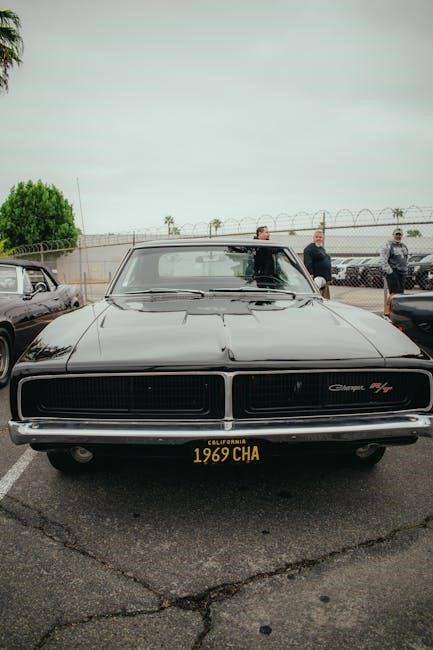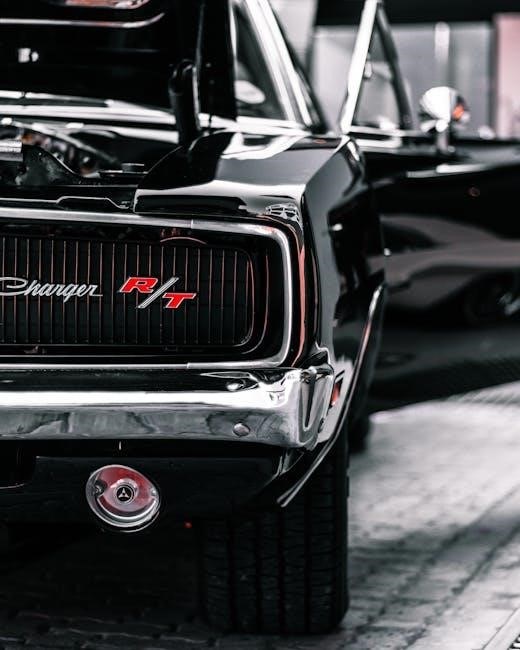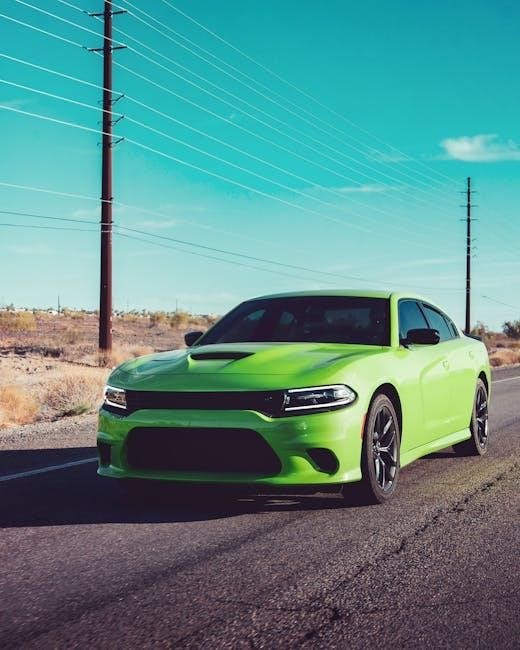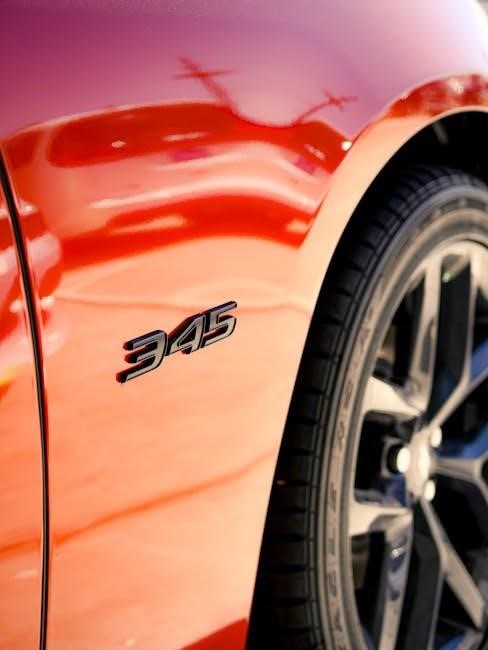dodge charger manual
Welcome to the Dodge Charger manual, your comprehensive guide to understanding and maintaining your vehicle. This manual covers history, features, maintenance, and troubleshooting to ensure optimal performance and longevity.
Purpose of the Manual
The purpose of the Dodge Charger manual is to provide owners with essential information for optimal vehicle operation, maintenance, and troubleshooting. It serves as a comprehensive guide to understanding the car’s features, ensuring safety, and maximizing performance. The manual covers routine maintenance schedules, diagnostic procedures, and repair guidelines to help owners address common issues. Additionally, it offers insights into advanced customization options and performance enhancements, allowing drivers to personalize their driving experience. By following the manual’s instructions, owners can extend the lifespan of their vehicle, maintain its value, and enjoy a smoother, more efficient ride. This resource is designed to empower drivers with knowledge, helping them make informed decisions about their Dodge Charger’s care and upgrades.
What to Expect
In this manual, you’ll find detailed insights into the Dodge Charger’s history, features, and maintenance requirements. It covers the evolution of the Charger, from its classic designs to modern advancements, ensuring a deep understanding of your vehicle. The guide provides step-by-step instructions for routine maintenance, troubleshooting common issues, and optimizing performance. Additionally, it explores customization options, allowing you to personalize your Charger to suit your preferences. Whether you’re a seasoned enthusiast or a new owner, this manual offers practical advice and technical specifications to enhance your driving experience. By following its guidance, you’ll be able to keep your Dodge Charger in peak condition, ensuring reliability and enjoyment for years to come.

History of the Dodge Charger
The Dodge Charger debuted in 1966 as a fastback muscle car, becoming an icon of American automotive history. Its bold design and powerful engine options solidified its legacy over decades, evolving through generations while maintaining its rebellious spirit and performance heritage.
Evolution Over the Years
The Dodge Charger has undergone significant transformations since its debut in 1966. Initially a fastback muscle car, it evolved into a four-door sedan in 2006 while retaining its performance legacy. Over the years, the Charger embraced advancements in engine technology, from V6 to V8 options, including the iconic HEMI. The introduction of the SRT Hellcat in 2015 marked a pinnacle in power with 707 horsepower. Modern iterations integrate cutting-edge technology, adaptive suspensions, and infotainment systems. Despite rumors of discontinuing manual transmissions, the Charger remains a symbol of American automotive history, blending heritage with innovation. Its enduring appeal lies in its balance of power, style, and practicality, making it a timeless favorite among car enthusiasts.
Notable Models and Editions
The Dodge Charger has boasted several iconic models, each contributing to its legacy. The 1969 R/T, with its 440 Magnum V8, is a classic. The 1970 Super Bee, known for its bold styling, remains a collector’s gem. In 2015, the SRT Hellcat emerged, delivering 707 horsepower. Limited editions like the Daytona and Scat Pack have further enhanced its appeal. Special trims such as the Charger Pursuit for law enforcement highlight its versatility. Each model showcases Dodge’s commitment to power and performance, ensuring the Charger remains a standout in automotive history.

Key Features of the Dodge Charger
The Dodge Charger offers powerful engine options, including the iconic Hellcat V8, manual transmission choices, and a blend of classic muscle car styling with modern tech features.
Engine Specifications
The Dodge Charger features a range of powerful engines, including the 6.2L supercharged HEMI® Hellcat V8, delivering 717 horsepower and 650 lb-ft of torque. The R/T models offer a 5.7L V8 with 370 horsepower, while the SXT trim includes a 3.6L V6 for efficiency. The Charger also introduces the Sixpack option, a 6.4L V8 producing 485 horsepower. These engines are paired with either an 8-speed automatic or, in select models, a manual transmission for driver control. The Hellcat Redeye takes performance further with 797 horsepower, making it a standout for enthusiasts. These specifications ensure the Charger remains a leader in power and performance within its class.
Interior and Technology
The Dodge Charger boasts a premium interior with supportive seating and advanced technology features. The cabin is equipped with a Uconnect infotainment system, offering an intuitive 10.1-inch touchscreen display. Bluetooth connectivity, Apple CarPlay, and Android Auto ensure seamless smartphone integration. A customizable 7-inch digital cluster provides essential vehicle data, while the optional Harman Kardon audio system delivers high-quality sound. Additional features include a wireless charging pad and multiple USB ports for convenient device charging. The Charger also offers driver-assistance technologies like adaptive cruise control and lane-keeping assist, enhancing safety and convenience. The interior combines modern design with practical functionality, ensuring a comfortable and connected driving experience.

Transmission and Performance
The Dodge Charger offers both manual and automatic transmissions, providing smooth shifting and precise control. With a range of engine options, it delivers impressive torque and horsepower, ensuring dynamic acceleration and responsive handling for an exhilarating driving experience.
Manual vs. Automatic Transmission
The Dodge Charger offers both manual and automatic transmissions, catering to diverse driving preferences. Manual transmissions provide precise control and a more engaging driving experience, ideal for enthusiasts. Automatic transmissions, on the other hand, offer convenience and smooth shifting, suitable for everyday driving. The manual option often appeals to those who enjoy driving dynamics, while the automatic is preferred for its ease of use. Both options are designed to maximize performance and efficiency, ensuring a seamless driving experience. The choice between manual and automatic ultimately depends on personal preference and driving habits, with both delivering exceptional power and responsiveness.
Performance Metrics
The Dodge Charger delivers exceptional performance, with models like the SRT Hellcat producing over 700 horsepower and achieving 0-60 mph in just 3.6 seconds. The Charger Sixpack, announced for 2025, promises thrilling acceleration and agility. Advanced engine technologies, including supercharged V8s, ensure robust power delivery. Handling is enhanced by precise steering and adaptive suspensions, making the Charger a formidable choice for both straight-line speed and cornering. Whether equipped with a manual or automatic transmission, the Charger excels in performance, offering drivers a blend of raw power and refined control. Its capabilities make it a standout in its class, catering to enthusiasts who demand superior acceleration and responsiveness behind the wheel.

Maintenance and Care
Regular maintenance is crucial for the Dodge Charger’s longevity. Follow scheduled services, check fluids, and monitor tire pressure to ensure optimal performance and prevent issues.
Scheduled Maintenance

Regularly scheduled maintenance is essential to keep your Dodge Charger performing at its best. Follow the recommended service intervals outlined in your owner’s manual, which include oil changes, tire rotations, and fluid checks. Ensure brake systems are inspected periodically, and address any worn components promptly. Battery health should be checked annually, especially in extreme climates. Adhere to the specified torque values for wheels and tires to maintain safety and performance. Fuel requirements must be met precisely to avoid engine damage. By following these guidelines, you can prevent major issues and extend the lifespan of your vehicle. Always refer to your manual for detailed schedules and specific recommendations tailored to your Charger’s model year and mileage.
Tips for Longevity

To ensure your Dodge Charger lasts for years, adopt a proactive approach to care. Regularly inspect and replace air filters to improve fuel efficiency and engine performance. Avoid aggressive driving habits, such as rapid acceleration or braking, which can strain the vehicle’s systems. Store your Charger in a cool, dry place during extended periods of inactivity to protect the paint and interior. Use high-quality fuels and fluids to maintain engine health. Monitor modifications, especially performance enhancements, to avoid overtaxing the vehicle. Keep your Charger clean, inside and out, to prevent rust and maintain its aesthetic appeal. By following these practices, you can preserve your vehicle’s durability, performance, and overall value.

Troubleshooting Common Issues
Identify common problems like error lights or performance issues by consulting diagnostic tools and the manual. Addressing issues early prevents major repairs and ensures reliable operation.
Diagnosing Problems
Diagnosing issues in your Dodge Charger begins with understanding warning lights and error codes. Use an OBD-II scanner to retrieve specific fault codes from the vehicle’s computer. Consult the manual for code interpretations and follow step-by-step troubleshooting guides. Pay attention to unusual sounds, vibrations, or performance changes. Regularly check fluid levels, tire pressure, and battery condition to identify potential issues early. If a problem persists, refer to the troubleshooting section of the manual for detailed instructions. Always address issues promptly to prevent minor problems from becoming major repairs. For complex issues, consult a certified technician or the dealership for professional assistance.
Repair and Replacement
When repairing or replacing components in your Dodge Charger, always refer to the manual for specific instructions and torque specifications. Use genuine Mopar parts to ensure compatibility and maintain performance. For complex repairs, consult a certified technician or the dealership to avoid further damage. Regularly inspect and replace wear items like brakes, belts, and tires to prevent unexpected failures. If encountering issues like unintended acceleration or transmission problems, follow the diagnostic procedures outlined in the manual. Keep a record of all repairs and maintenance for future reference. Addressing problems promptly ensures reliability and extends the lifespan of your vehicle. Always follow safety guidelines when working under the hood or with electrical systems.

Safety Features
The Dodge Charger is equipped with advanced safety technologies, including adaptive cruise control, lane departure warning, and emergency braking systems. These features enhance driver confidence.
Advanced Safety Technologies
The Dodge Charger features cutting-edge safety systems, including Forward Collision Warning and Active Braking, designed to prevent accidents by monitoring the road ahead. LaneSense technology assists drivers in staying within their lane, while Adaptive Cruise Control maintains a safe distance from other vehicles. Blind-spot monitoring and rear cross-path detection enhance visibility when changing lanes or reversing. Additionally, the Charger offers a 360-degree camera system for improved awareness during parking and low-speed maneuvers. These technologies work seamlessly to provide a secure driving experience, ensuring both driver and passenger safety on the road. Regular updates and maintenance ensure these systems function optimally, as outlined in the owner’s manual.
Emergency Procedures
In the event of an emergency, the Dodge Charger is equipped with systems to help ensure safety. For a fire, use the fire extinguisher located in the trunk. If the vehicle must be evacuated, ensure all occupants exit safely and move to a secure location. For a breakdown, activate hazard lights and use warning triangles or flares. In case of a collision, check for injuries and call emergency services immediately. The manual also outlines procedures for towing and jump-starting. Always keep a first-aid kit and emergency contact information accessible. Familiarize yourself with these procedures to handle unexpected situations confidently and safely. Regular checks of emergency equipment, as detailed in the manual, are crucial for preparedness. Stay calm and follow the outlined steps to minimize risks and ensure a safe resolution.

Owner’s Responsibilities
Owners must perform regular maintenance, adhere to manual guidelines, and ensure the vehicle is in safe, proper condition for operation to uphold performance and longevity standards.
Regular Checks
Regular checks are essential for maintaining your Dodge Charger’s health. These include inspecting the brake system, monitoring fluid levels, and ensuring proper tire torque specifications. Routine maintenance tasks, such as oil changes and filter replacements, should be performed according to the schedule outlined in the manual. Additionally, keeping an eye on dashboard lights and addressing any issues promptly can prevent minor problems from becoming major repairs. By following the guidelines, you ensure the vehicle operates safely and efficiently, preserving its performance and longevity. These checks are crucial for upholding the vehicle’s condition and ensuring a smooth driving experience. Regular inspections also help in identifying potential issues early, saving time and money in the long run. Always refer to the manual for specific instructions and recommendations tailored to your Dodge Charger model. This proactive approach ensures your vehicle remains in optimal condition, providing years of reliable service. Regular checks are a cornerstone of responsible vehicle ownership, fostering safety and maintaining the integrity of your Dodge Charger.
Adhering to Guidelines
Adhering to the guidelines in your Dodge Charger manual ensures safe and optimal vehicle operation. Following the recommended maintenance schedule, fluid requirements, and safety precautions helps maintain performance and longevity. The manual provides specific instructions tailored to your vehicle’s model, ensuring compliance with manufacturer standards. Ignoring these guidelines may lead to reduced efficiency, potential damage, or safety risks. Always refer to the manual for proper procedures, such as diagnosing issues or performing repairs. By following the outlined recommendations, you protect your investment and ensure a smooth driving experience. Adhering to the manual’s instructions also helps preserve your vehicle’s warranty and resale value. Proper adherence to guidelines is essential for responsible ownership and maintaining the integrity of your Dodge Charger. This ensures your vehicle remains reliable and performs at its best for years to come.
Advanced Customization and Modifications
Advanced customization and modifications for your Dodge Charger can enhance performance and aesthetic appeal. Explore engine upgrades, suspension tuning, and exterior styling options to make your Charger unique. From performance-enhancing mods like superchargers to aesthetic tweaks like custom paint jobs, these modifications allow you to personalize your vehicle. Always consult the manual to ensure modifications align with manufacturer guidelines and maintain warranty compliance; This section helps you unlock your Charger’s full potential while preserving its integrity and performance capabilities over time.
Performance Enhancements
Performance enhancements for your Dodge Charger can significantly boost power and agility. Consider upgrading to a cold-air intake or high-performance exhaust system to improve engine efficiency. Installing a supercharger or turbocharger can dramatically increase horsepower, making your Charger a formidable powerhouse. Suspension upgrades, such as coilovers and sway bars, enhance handling for a smoother, sportier ride. Additionally, lightweight wheels and high-performance tires can improve acceleration and cornering. For those seeking extreme power, modifications like enlarged injectors and engine tuning can push the limits of your Charger’s capabilities. Always ensure modifications are done by professionals and comply with manufacturer guidelines to maintain safety and warranty. These enhancements allow you to tailor your Charger to your driving style, whether on the track or the street.
Aesthetic Modifications
Aesthetic modifications allow you to personalize your Dodge Charger, making it stand out on the road. Unique paint options, such as Panther Pink, can add rarity and style. Custom body kits, including spoilers and bumpers, enhance the vehicle’s aggressive stance. Upgraded wheels, like forged alloys, improve both aesthetics and performance. Interior upgrades, such as premium leather seats and ambient lighting, elevate comfort and visual appeal. Additionally, enthusiasts often opt for vinyl wraps or decals for a bold, personalized look; For those seeking exclusivity, limited-edition models or bespoke designs can make your Charger truly one-of-a-kind. These modifications not only enhance visual appeal but also reflect your personal style, turning your Charger into a statement piece. Always ensure modifications comply with safety and legal standards to maintain reliability and resale value.











Leave a Comment